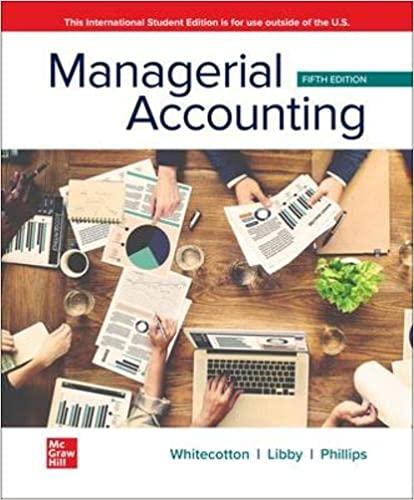Question
The Riteway Ad Agency provides cars for its sales staff. In the past, the company has always purchased its cars from a dealer and then
The Riteway Ad Agency provides cars for its sales staff. In the past, the company has always purchased its cars from a dealer and then sold the cars after three years of use. The companys present fleet of cars is three years old and will be sold very shortly. To provide a replacement fleet, the company is considering two alternatives:
| Purchase alternative: | The company can purchase the cars, as in the past, and sell the cars after three years of use. Ten cars will be needed, which can be purchased at a discounted price of $18,000 each. If this alternative is accepted, the following costs will be incurred on the fleet as a whole: |
| Annual cost of servicing, taxes, and licensing | $ | 3,400 |
| Repairs, first year | $ | 1,300 |
| Repairs, second year | $ | 3,800 |
| Repairs, third year | $ | 5,800 |
At the end of three years, the fleet could be sold for one-half of the original purchase price.
| Lease alternative: | The company can lease the cars under a three-year lease contract. The lease cost would be $53,000 per year (the first payment due at the end of Year 1). As part of this lease cost, the owner would provide all servicing and repairs, license the cars, and pay all the taxes. Riteway would be required to make a $12,000 security deposit at the beginning of the lease period, which would be refunded when the cars were returned to the owner at the end of the lease contract. |
Riteway Ad Agencys required rate of return is 14%.
Click here to view Exhibit 12B-1 and Exhibit 12B-2, to determine the appropriate discount factor(s) using tables.
Required:
1. What is the net present value of the cash flows associated with the purchase alternative?
2. What is the net present value of the cash flows associated with the lease alternative?
3. Which alternative should the company accept?
The Elberta Fruit Farm of Ontario always has hired transient workers to pick its annual cherry crop. Janessa Wright, the farm manager, just received information on a cherry picking machine that is being purchased by many fruit farms. The machine is a motorized device that shakes the cherry tree, causing the cherries to fall onto plastic tarps that funnel the cherries into bins. Ms. Wright has gathered the following information to decide whether a cherry picker would be a profitable investment for the Elberta Fruit Farm:
- Currently, the farm is paying an average of $160,000 per year to transient workers to pick the cherries.
- The cherry picker would cost $152,000. It would be depreciated using the straight-line method and it would have no salvage value at the end of its 10-year useful life.
- Annual out-of-pocket costs associated with the cherry picker would be: cost of an operator and an assistant, $92,000; insurance, $4,000; fuel, $11,000; and a maintenance contract, $14,000.
2a. Compute the simple rate of return expected from the cherry picker.
4a. Compute the internal rate of return promised by the cherry picker.
Step by Step Solution
There are 3 Steps involved in it
Step: 1

Get Instant Access to Expert-Tailored Solutions
See step-by-step solutions with expert insights and AI powered tools for academic success
Step: 2

Step: 3

Ace Your Homework with AI
Get the answers you need in no time with our AI-driven, step-by-step assistance
Get Started


